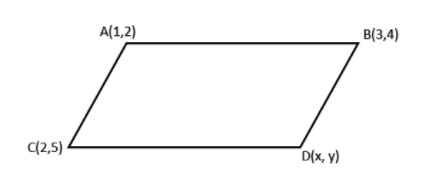
In a parallelogram ABDC, the coordinates of A, B, C are (1, 2), (3, 4) and (2, 5) respectively. Then find the equation of diagonal AD.
Answer
534.9k+ views
Hint: First let us take the coordinate of D to be (x, y). Now we know that the opposite sides of parallelogram are same hence the slope of the opposite sides will also be same we know that the slope of the line is given by $\dfrac{{{y}_{2}}-{{y}_{1}}}{{{x}_{2}}-{{x}_{1}}}$. Hence we will form two equations in x and y and find the coordinate of D. Now we know that the line joining two point is given by $\dfrac{y-{{y}_{1}}}{{{y}_{1}}-{{y}_{2}}}=\dfrac{x-{{x}_{1}}}{{{x}_{1}}-{{x}_{2}}}$ Hence we will find the equation of AD.
Complete step by step answer:
Now we are given that ABDC is a parallelogram such that the coordinates of A, B, C are (1, 2), (3, 4) and (2, 5) respectively. Now let us assume the coordinate of D to be (x, y)
Let us first draw the figure of parallelogram.
Now we know that the opposite sides of a parallelogram are parallel.

Now we know that the slope of line joining $\left( {{x}_{1}},{{y}_{1}} \right)$ and $\left( {{x}_{2}},{{y}_{2}} \right)$ is given by $\dfrac{{{y}_{2}}-{{y}_{1}}}{{{x}_{2}}-{{x}_{1}}}$
Now we also know that parallel lines have equal slope.
Hence we can say that the slopes of the lines joining AB and CD will be equal and the slope of line joining BD and AC will be equal.
Hence we can say that,
$\Rightarrow \dfrac{2-5}{1-2}=\dfrac{4-y}{3-x}$ and $\dfrac{4-2}{3-1}=\dfrac{y-5}{x-2}$
Now simplifying the equations we get,
$\Rightarrow 3=\dfrac{4-y}{3-x}$ and $1=\dfrac{y-5}{x-2}$
Now first let us consider the equation $3=\dfrac{4-y}{3-x}$
Taking 3 – x to LHS we get, $9-3x=4-y$
Hence on rearranging the terms of the equation we get,
$\Rightarrow 3x-y=5..........\left( 1 \right)$
Now consider the equation $1=\dfrac{y-5}{x-2}$
Taking x – 2 on LHS we get, $x-2=y-5$
Now rearranging the terms of the equation we get,
$\Rightarrow x-y=-3........\left( 2 \right)$
Now subtracting equation (2) from equation (1) we get,
$\begin{align}
& \Rightarrow 2x=5-\left( -3 \right) \\
& \Rightarrow 2x=8 \\
& \Rightarrow x=4 \\
\end{align}$
Now substituting the value of x in equation (1) we get, y = $3\left( 4 \right)-5=7$.
Hence the coordinate of D is (4, 0).
Now let us find the equation of AD.
We know that the equation of line joining two points $\left( {{x}_{1}},{{y}_{1}} \right)$ and $\left( {{x}_{2}},{{y}_{2}} \right)$ is given by $\dfrac{y-{{y}_{1}}}{{{y}_{1}}-{{y}_{2}}}=\dfrac{x-{{x}_{1}}}{{{x}_{1}}-{{x}_{2}}}$
Hence the equation of line joining A (1, 2) and D (4, 7) is given by,
$\begin{align}
& \Rightarrow \dfrac{y-7}{7-2}=\dfrac{x-4}{4-1} \\
& \Rightarrow \dfrac{y-7}{5}=\dfrac{x-4}{3} \\
& \Rightarrow 3y-21=5x-20 \\
& \Rightarrow 5x-3y+1=0 \\
\end{align}$
Hence the equation of diagonal is 5x + 3y + 1 = 0.
Note: Now note that we also have a property that the diagonals of parallelogram are perpendicular and the multiplication of slopes of perpendicular lines is – 1. Hence we can also form an equation by using this property and solve the equation.
Complete step by step answer:
Now we are given that ABDC is a parallelogram such that the coordinates of A, B, C are (1, 2), (3, 4) and (2, 5) respectively. Now let us assume the coordinate of D to be (x, y)
Let us first draw the figure of parallelogram.
Now we know that the opposite sides of a parallelogram are parallel.

Now we know that the slope of line joining $\left( {{x}_{1}},{{y}_{1}} \right)$ and $\left( {{x}_{2}},{{y}_{2}} \right)$ is given by $\dfrac{{{y}_{2}}-{{y}_{1}}}{{{x}_{2}}-{{x}_{1}}}$
Now we also know that parallel lines have equal slope.
Hence we can say that the slopes of the lines joining AB and CD will be equal and the slope of line joining BD and AC will be equal.
Hence we can say that,
$\Rightarrow \dfrac{2-5}{1-2}=\dfrac{4-y}{3-x}$ and $\dfrac{4-2}{3-1}=\dfrac{y-5}{x-2}$
Now simplifying the equations we get,
$\Rightarrow 3=\dfrac{4-y}{3-x}$ and $1=\dfrac{y-5}{x-2}$
Now first let us consider the equation $3=\dfrac{4-y}{3-x}$
Taking 3 – x to LHS we get, $9-3x=4-y$
Hence on rearranging the terms of the equation we get,
$\Rightarrow 3x-y=5..........\left( 1 \right)$
Now consider the equation $1=\dfrac{y-5}{x-2}$
Taking x – 2 on LHS we get, $x-2=y-5$
Now rearranging the terms of the equation we get,
$\Rightarrow x-y=-3........\left( 2 \right)$
Now subtracting equation (2) from equation (1) we get,
$\begin{align}
& \Rightarrow 2x=5-\left( -3 \right) \\
& \Rightarrow 2x=8 \\
& \Rightarrow x=4 \\
\end{align}$
Now substituting the value of x in equation (1) we get, y = $3\left( 4 \right)-5=7$.
Hence the coordinate of D is (4, 0).
Now let us find the equation of AD.
We know that the equation of line joining two points $\left( {{x}_{1}},{{y}_{1}} \right)$ and $\left( {{x}_{2}},{{y}_{2}} \right)$ is given by $\dfrac{y-{{y}_{1}}}{{{y}_{1}}-{{y}_{2}}}=\dfrac{x-{{x}_{1}}}{{{x}_{1}}-{{x}_{2}}}$
Hence the equation of line joining A (1, 2) and D (4, 7) is given by,
$\begin{align}
& \Rightarrow \dfrac{y-7}{7-2}=\dfrac{x-4}{4-1} \\
& \Rightarrow \dfrac{y-7}{5}=\dfrac{x-4}{3} \\
& \Rightarrow 3y-21=5x-20 \\
& \Rightarrow 5x-3y+1=0 \\
\end{align}$
Hence the equation of diagonal is 5x + 3y + 1 = 0.
Note: Now note that we also have a property that the diagonals of parallelogram are perpendicular and the multiplication of slopes of perpendicular lines is – 1. Hence we can also form an equation by using this property and solve the equation.
Recently Updated Pages
In cricket, what is a "pink ball" primarily used for?

In cricket, what is the "new ball" phase?

In cricket, what is a "death over"?

What is the "Powerplay" in T20 cricket?

In cricket, what is a "super over"?

In cricket, what is a "tail-ender"?

Trending doubts
Why is there a time difference of about 5 hours between class 10 social science CBSE

Write a letter to the principal requesting him to grant class 10 english CBSE

Write an application to the principal requesting five class 10 english CBSE

What is the median of the first 10 natural numbers class 10 maths CBSE

The Equation xxx + 2 is Satisfied when x is Equal to Class 10 Maths

Who Won 36 Oscar Awards? Record Holder Revealed




